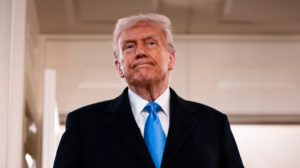In 2025, former U.S. President Donald Trump made headlines by signing a new executive order that promised to declassify various high-profile U.S. government secrets. This decision has stirred significant public interest, with many wondering what kinds of explosive revelations might be revealed. Among the most anticipated documents to be declassified are those related to the late financier Jeffrey Epstein, whose controversial connections with powerful individuals have fueled widespread speculation.
One of the key aspects of Trump’s declassification agenda is the potential release of Jeffrey Epstein’s infamous “little black book,” which reportedly contains the names and contact information of many influential figures who were associated with Epstein. This book is rumored to list prominent politicians, business leaders, celebrities, and other high-profile individuals who allegedly had ties to Epstein, a man whose criminal activities—including sex trafficking and abuse of underage girls—were only fully revealed after his arrest and subsequent death in 2019.
Epstein’s little black book has long been the subject of intense curiosity, with conspiracy theorists and investigative journalists attempting to uncover its contents. The release of this book would not only shine a light on the people who were allegedly involved in or aware of Epstein’s crimes, but it could also prompt a larger investigation into the power dynamics that allowed him to operate unchecked for so long. While it’s still unclear exactly how much of the book will be released or what level of detail the government will provide, this declassification is sure to make waves.
In addition to the Epstein documents, Trump’s executive order also directs the release of other previously classified materials. Among these are files related to the assassinations of prominent figures such as President John F. Kennedy, Senator Robert F. Kennedy, and civil rights leader Dr. Martin Luther King Jr. These files are expected to provide additional insight into the events surrounding their deaths, with many believing that the truth has been hidden for decades.
Trump has also promised to declassify materials related to the origins of the COVID-19 pandemic, particularly documents that could provide clarity on whether the virus originated in a laboratory or from natural sources. This is a topic that has been the subject of intense debate, and many are eager to see whether newly revealed documents will support or challenge various theories.
Finally, Trump’s declassification plan includes the release of materials related to UFOs and unidentified aerial phenomena (UAP). Over the past few years, the U.S. government has slowly declassified some information about UAP encounters, but many believe there is still much more to be revealed. Trump’s order could provide additional details about encounters with unidentified flying objects, including military sightings and government investigations into their origins and nature.
While the full extent of the secrets that will be declassified remains unclear, Trump’s move has certainly generated excitement among those hoping to uncover hidden truths about U.S. history. Whether it leads to dramatic revelations or not, these declassified files will undoubtedly shape the public’s understanding of the events they cover, as well as the broader power structures that have influenced American society for decades.


